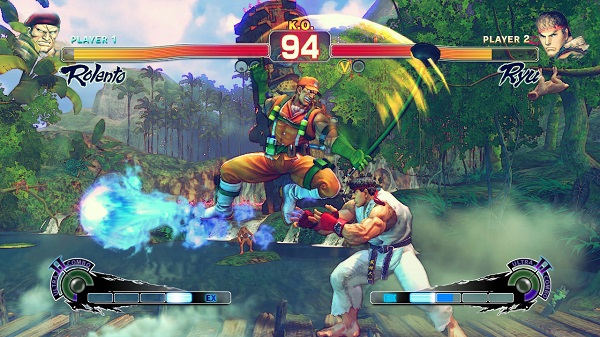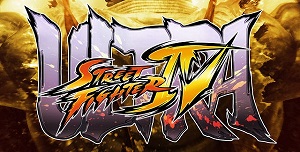 PLATFORM: PS3, Xbox 360, PC (Reviewed)
PLATFORM: PS3, Xbox 360, PC (Reviewed)
PRICE: $29.99 (Full), 14:99 (Digital Upgrade from SSFIV/SSFIV:AE)
ESRB RATING: T
PUBLISHER: Capcom
DEVELOPER: Dimps/Capcom
GET IT ON PSN: Here
GET IT ON XBLA: Here
GET IT ON STEAM: Here
Claimed to be the final upgrade in the Street Fighter IV cycle, Ultra Street Fighter IV is the pinnacle of the fourth iteration of Capcom’s landmark fighting franchise.
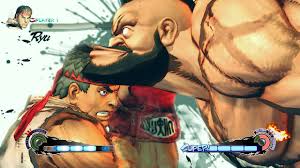 But then again, we all knew that, didn’t we? Might as well cut to the chase about it. Capcom are notorious for upgrading each chapter of the Street Fighter saga, essentially milking numerous re-releases of… Well, ‘the same game’ isn’t really fair, since the changes made tend to be significant and for the better, but the Street Fighter template is as much a framework as any one game. Each iteration is designed to be built on with each new re-release, as many times as necessary to push that framework to its optimal limits (Or as long as the market accepts the rereleases).
But then again, we all knew that, didn’t we? Might as well cut to the chase about it. Capcom are notorious for upgrading each chapter of the Street Fighter saga, essentially milking numerous re-releases of… Well, ‘the same game’ isn’t really fair, since the changes made tend to be significant and for the better, but the Street Fighter template is as much a framework as any one game. Each iteration is designed to be built on with each new re-release, as many times as necessary to push that framework to its optimal limits (Or as long as the market accepts the rereleases).
What I’m saying is, you don’t need me to tell you that USFIV is great: you already know it is. But that doesn’t mean that there aren’t things to talk about, especially when it comes to where the fighter genre has found itself recently.
First, the basics. Ultra preserves the tight, super-precise mechanics that we’ve all come to expect from Street Fighter IV but also throws in some important additions. The already monstrous character roster has been boosted with five new additions, including Final Fight alumni Hugo, Rolento and Poison, Street Fighter III‘s Elena and evil Cammy clone Decapre, as well as a raft of new stages taken from Street Fighter X Tekken. There’s also now an ‘Edition Select’ feature, taking a leaf from Hyper Street Fighter II‘s book, that lets you select different versions of characters from the other SFIV iterations. More crucially, however, we get several new mechanics introduced. You can now manually delay your character’s wakeup time on knockdown, which comes in handy when dealing with all those online Focus attack spammers, along with Red Focus attacks, which work like normal Focus attacks but with more invincibility hits. We also get a Double Ultra option, which makes both of a character’s Ultra Combos available simultaneously at the cost of reduced damage. Finally, in response to fan feedback most unblockable setups have been removed.
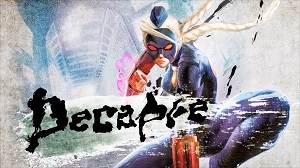 By and large these changes and additions serve to give the player more choices in terms of strategy and in responding to an opponent’s moves, though for the purposes of this review there are basically two kinds of people: those who will read the above paragraph and understand exactly what I’m talking about, and those who’ll just see a block of technical gibberish, which points to an irony which has haunted Street Fighter IV for some time: The original SFIV was conceived as an exercise of going ‘back to basics’, a reaction to the complexity of SFIII to woo older fans back to the franchise. Yet with each new update SFIV has gradually gone back to courting the hardcore crowd more and more to the point where we’re basically right where we were in terms of technical denseness as in the SFIII days.
By and large these changes and additions serve to give the player more choices in terms of strategy and in responding to an opponent’s moves, though for the purposes of this review there are basically two kinds of people: those who will read the above paragraph and understand exactly what I’m talking about, and those who’ll just see a block of technical gibberish, which points to an irony which has haunted Street Fighter IV for some time: The original SFIV was conceived as an exercise of going ‘back to basics’, a reaction to the complexity of SFIII to woo older fans back to the franchise. Yet with each new update SFIV has gradually gone back to courting the hardcore crowd more and more to the point where we’re basically right where we were in terms of technical denseness as in the SFIII days.
Most won’t mind this, especially the hardcore fans, and in those terms USFIV is a rousing success. It’s the best Street Fighter has always been, a lean, finely-tuned machine of virtual pugilism that is simply astounding in its precision, smoothness and depth. Older fans, however, who may have drifted in and out of the Street Fighter world over the years, may need to take some time to get up to speed with where the game is at these days. Unfortunately the game still does little to teach new or returning players these added nuances, the sparse tutorial/challenge mode now allowing online play with a friend but still feeling rather thin when it comes to actually teaching people how to build and string together the more advanced combos.
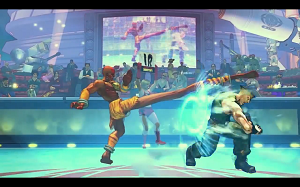 Single players will find themselves even more out in the cold. Single player has traditionally been looked upon as the red-headed stepchild of the fighting game world, that weird thing that some people do even if it’s never really been the point of the exercise. Fighting games have traditionally been designed for local multiplayer first, online multiplayer second and single player at a distant last, past the traditional scant Arcade Mode designed for coin-feeding casuals rather than ‘real’ fighting game fans. As a result of this philosophy, complaining about the lack of single-player content in fighting games has always been slightly verboten; even as an appreciator of a good fighter who generally plays single player, I’d always refrained from protesting too much because at the end of the day I knew that I wasn’t really playing these things properly.
Single players will find themselves even more out in the cold. Single player has traditionally been looked upon as the red-headed stepchild of the fighting game world, that weird thing that some people do even if it’s never really been the point of the exercise. Fighting games have traditionally been designed for local multiplayer first, online multiplayer second and single player at a distant last, past the traditional scant Arcade Mode designed for coin-feeding casuals rather than ‘real’ fighting game fans. As a result of this philosophy, complaining about the lack of single-player content in fighting games has always been slightly verboten; even as an appreciator of a good fighter who generally plays single player, I’d always refrained from protesting too much because at the end of the day I knew that I wasn’t really playing these things properly.
Ed Boon and his NetherRealm crew changed that philosophy for good.
Mortal Kombat 9 and Injustice: Gods Among Us proved that including substantial single-player content in a fighter was not only a viable approach, but that there was a huge audience out there just waiting for someone to do it. Going from these games to Ultra Street Fighter IV is a sobering reminder of what single player in fighting games used to mean, i.e. all Arcade Mode, some sub-par Practice Room dalliance, and a whole lot more Arcade Mode. The classic ‘four/five opponents then final boss’ structure feels drab and perfunctory nowadays, especially when you still have the perennially cheap Seth waiting to annoy you at the end. He’s designed like a cheap Dr. Manhattan knockoff, his powers are a lazy grab-bag of all the other fighters’ moves and his ludicrously destructive grapples still have uncommon range – yep, Seth is still a major prick and ruins the Arcade Mode, which is a major bummer for those who prefer to play against the AI because you can’t avoid him.
 Of course, there is still online multiplayer to try and as always it seems to be a mixed bag. The Steam version is plagued with lag (Though Capcom are reportedly working on the netcode so hopefully this will improve soon) and opponents’ skill levels are predictably diverse, but newcomers will probably not want to venture into the online arena without getting to know the fighting system first – which brings us back to the game’s anaemic tutorial and single-player content. Those who have hardcore friends who can show them the ropes will thrive, but the game does little to help lone students along.
Of course, there is still online multiplayer to try and as always it seems to be a mixed bag. The Steam version is plagued with lag (Though Capcom are reportedly working on the netcode so hopefully this will improve soon) and opponents’ skill levels are predictably diverse, but newcomers will probably not want to venture into the online arena without getting to know the fighting system first – which brings us back to the game’s anaemic tutorial and single-player content. Those who have hardcore friends who can show them the ropes will thrive, but the game does little to help lone students along.
Ultra Street Fighter IV is a fantastic fighting game, but it’s a deeply contrary experience at this point in the evolution of fighters. It’s bursting with style, its roster is impeccable and its systems strike a keen balance between complexity and accessibility. It’s genuinely state of the art in fighting game terms, but it’s saddled with a traditional requirement to have other people around – and preferably huddled around the screen with you – to actually get the full benefit of its charms. It’s either everything you’d ever want in a fighter or just not good enough, depending on your skill level and circumstances, and while that used to be a dichotomy that was par for the course in the fighting game world, it doesn’t have to be so now.
That’s why I’ve decided to do something a little different, and give Ultra Street Fighter IV two scores: one for those who only play local or online multiplayer, and one for the single-player contingent. Some might consider this a cop-out, but it just feels like the fairest way around it. It feels more and more that these games’ audience are fundamentally divided in terms of circumstances and skill, and maybe it’s time that we started reflecting that. As an extension of the already existing SFIV structure it’s not entirely fair to be too hard on Ultra for not changing the status quo; however, times have changed and one can only hope that Capcom have been taking note of NetherRealm’s approach, and rethink the single-player experience for the inevitable Street Fighter V.
In the meantime, we’ll just have to make do with a masterpiece for a very select crowd.
MULTIPLAYER: Rating: 




Out of a Possible 5 Stars
SINGLE PLAYER: Rating: 




Out of a Possible 5 Stars
